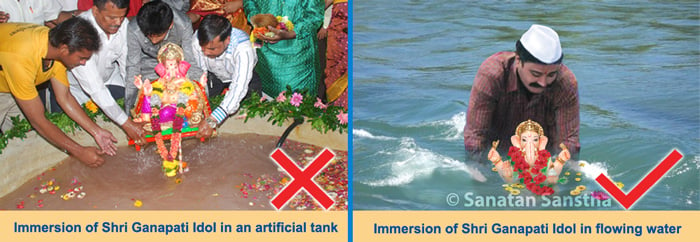
Under the pretext of pollution-free immersion of Shri Ganapati Idols, some municipal corporations, local administrations, heretic organisations, non-Governmental organisations etc. build provisional tanks everywhere. It is inappropriate to immerse Shri Ganapati Idols in such tanks because of the following reasons :
A. The scriptures say that Idols that have been ritualistically consecrated should be immersed in flowing water. By immersing the Idol in flowing water, the Chaitanya (Divine consciousness) of the Idol reaches everywhere and many people benefit from it. Since the water in a man-made tank does not flow, the devotees are deprived of spiritual benefits.
B. After immersion of Idols in man-made tanks, associated workers remove the Idols even before they dissolve in water.
C. Idols immersed in man-made tanks are taken away by municipal corporations in their garbage vans.
D. After immersion of the Idols, the water (which is charged with Shri Ganapati Principle) is thrown into gutters by municipal corporations to facilitate leveling of the ground with rubble. This also amounts to a sort of denigration of Shri Ganapati.
Alternatives for immersion of Shri Ganapati Idols
in the famine-stricken areas or in emergency situations
If the rainfall is scanty in a year, rivers and streams dry up. Hence, there is a possibility of facing difficulties in immersing the Idols as per the scriptures. Scriptures sanction religious actions in a famine situation if performed according to the principles of Spirituality. Accordingly, in a famine situation, the alternatives given ahead can be adopted for immersion.
1. Installing a small Idol
A. Though there may be a custom of bringing home a big Idol, in a famine situation a small Idol should be worshipped so that it is easier to immerse.
B. After the ritualistic worship for immersion, the Idol may be taken out of the house and immersed in a big vessel of water placed near the tulsi-vrundavan (A small rectangular structure in which the tulsi [Holy basil plant] is grown) or in the courtyard. People living in flats in cities should immerse the Idols in a big vessel of water in the house itself since there is no tulsi-vrundavan or courtyard in a flat.
C. After the Idol fully dissolves in water, the water and clay should be offered to sattvik trees (such as Apta [Mountain Ebony], Banyan and Peepal [Bo tree]) in a manner that the water and clay are not trodden upon.
2. If it is not possible to install a small Idol, a big Idol
may be installed and immersed later after due ritualistic worship
If it is not possible to install a small Idol, we can install a big Idol, perform ritualistic worship as done before immersion and place it in a sattvik place in the house itself (such as near the temple in the house). There is no need to worship this Idol daily. It should be placed in a box or covered with cloth to prevent it from getting covered by dust. Later, when flowing water is available, the Idol may be immersed in it.
3. Worshipping a betel nut symbolically as Shri Ganapati
Instead of consecrating an Idol, place a betel nut and worship it symbolically as Shri Gaṇapati. The betel nut can be immersed in a small well or a stream.’
– Shri. Damodar Vaze Guruji, Administrator, Sanatan Seeker-Priest School, Ramnathi, Goa.

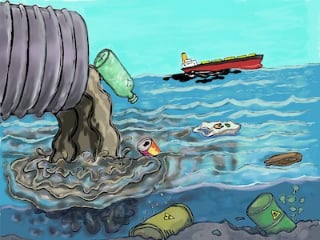 Blind eye of fake reformers, who oppose immersion of Ganesh Idols, towards water pollution caused...
Blind eye of fake reformers, who oppose immersion of Ganesh Idols, towards water pollution caused... Why do those who raise issue of water pollution during Ganesh festival, not dare to...
Why do those who raise issue of water pollution during Ganesh festival, not dare to...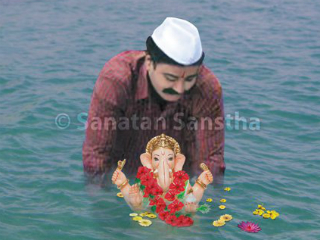 Why should we immerse Shri Ganesh idols in flowing water?
Why should we immerse Shri Ganesh idols in flowing water?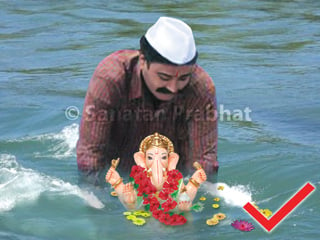 Water reservoirs don’t get polluted due to immersion of Ganesh idols : GPCB
Water reservoirs don’t get polluted due to immersion of Ganesh idols : GPCB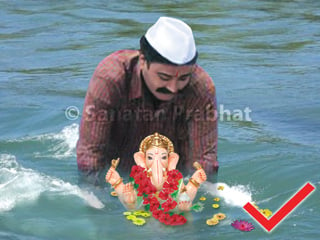 Sri Ganeshji Visarjan – Ananta Chaturdashi
Sri Ganeshji Visarjan – Ananta Chaturdashi